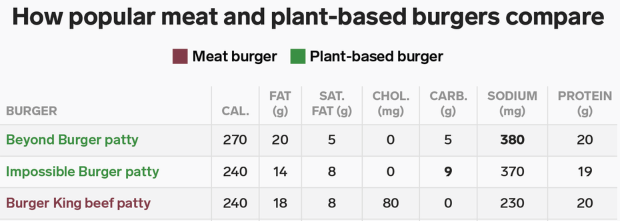8/16/2019
BY: JOHN SPILLSON
.jpg.aspx?width=300&height=200) By far the biggest buzz in the food industry in 2019 is the rise of alternative meat products. Whether it's with Beyond Meat's phenomenal growth and stock market stardom, Impossible Burger, Quorn, the long-standing Garden Burger, or even old tofu standbys like Tofurkey, the world is seeking an alternative to traditional meat options more than ever before.
By far the biggest buzz in the food industry in 2019 is the rise of alternative meat products. Whether it's with Beyond Meat's phenomenal growth and stock market stardom, Impossible Burger, Quorn, the long-standing Garden Burger, or even old tofu standbys like Tofurkey, the world is seeking an alternative to traditional meat options more than ever before.
But why now? Some consumers are fueled by the desire to improve their diet by cutting back on their red meat consumption. Others are hoping to reduce their environmental impact by choosing more sustainable food options. With these goals in mind, let's see how these various meat alternatives stack up against each other and the real thing.
Can Burgers Ever Be 'Healthy'?
What could be healthier than a plant-based product? After all, they're made with natural, fat-free ingredients that never had a heartbeat and never walked the earth. But does that necessarily mean they're healthier?
For starters, just a few of the ingredients used by some of the most popular products include pea protein isolate, canola oil, coconut oil, potato protein, modified food starch, soy leghemoglobin, yeast extract and beet juice extract. For those in search of a less processed food source, these are not the answer.
Going further, breaking down the nutritional information is eye-opening. When comparing the Beyond Burger, Impossible Burger and Burger King patties, the results may not be what one would expect (see chart below).

When comparing several of the most tracked categories of nutritional information, each 'burger' has its own good and bad points depending on what one is monitoring. While the Beyond Burger is highest in protein and lowest in saturated fat, it is highest in calories, sodium and overall fat. The Impossible Burger, on the other hand, is lowest in fat and cholesterol, but also highest in saturated fat and carbs. The Burger King beef patty, while highest in cholesterol, is lowest in carbs and sodium.
Using a ranking system for each of the seven nutritional categories in the chart above, the Impossible Burger and Burger King patty are tied for first with the Beyond Burger trailing behind by just a few points. Each product shines in some categories while falling behind in others, making it clear that an optimal meat alternative - in terms of nutrition - still has yet to be achieved.
How Sustainable Are Sustainable Products?
Nutrition aside, many seek out meat alternatives due to the perceived benefit these plant-based products have on the environment. But are these alternatives as sustainable as people are led to believe?
Last fall, the University of Michigan's Center for Sustainable Systems completed a life cycle analysis of Beyond Burger compared to that of a quarter pound of beef. This analysis followed their impacts from the time the product 'life' began to the time they were delivered to retail outlets. Impacts were measured by looking at greenhouse gas emissions, energy use, water consumption, land use and packaging.
The result: Beyond Burger generated 90% fewer greenhouse gas emissions, had 99% less impact on water scarcity, 93% less impact on land use and required 46% less energy compared to a quarter pound of beef. Put in other terms, this means that a 41-square foot plot of land could produce either one beef burger or 15 Beyond Burgers.
A similar study was conducted on the Impossible Burger and the results were equally shocking. The carbon footprint is essentially 89% smaller than traditional beef, with an 87% water reduction and 96% land reduction as well as 89% fewer greenhouse gas emissions. (On a humorous note, it's clear that if there's one thing cows do a lot of, it is expel greenhouse gases.)
Both Beyond Burger and Impossible Burger can utilize these impressive results to appeal to consumers who are concerned about sustainability and the impact they are having on the environment.
To Meat or Not To Meat? That is the Question
With most customer surveys showing that consumers enjoy the taste of these non-meat options, it remains unclear what the deciding factor will be in determining what they ultimately buy. Will it be the perceived nutritional benefit, or the proven benefit to the environment? Regardless of the reason for purchase, it appears these meat alternatives are here to stay.
What does this mean for food manufacturers in the market today? Whether the company produces meat, meat alternatives or a different food product entirely, this trend speaks to larger industry transformations that will inevitably arise as consumers continue to move towards healthier, more sustainable and less processed food choices. The question remains: will these products meat this new demand?
MEET OUR EXPERT
 John Spillson, Food Business Development Manager & Lean Business Advisor
John Spillson, Food Business Development Manager & Lean Business Advisor
John works to develop and expand the food program at The Center. His experience operating his own business has given him knowledge in production, sales, food safety, marketing, warehousing and logistics. John comes from a long line of entrepreneurs, following both parents and grandparents in operating their own family food businesses. Prior to joining The Center, John owned and operated his own food processing company for more than 20 years.
Since 1991, the Michigan Manufacturing Technology Center has assisted Michigan’s small and medium-sized businesses to successfully compete and grow. Through personalized services designed to meet the needs of clients, we develop more effective business leaders, drive product and process innovation, promote company-wide operational excellence and foster creative strategies for business growth and greater profitability. Find us at www.the-center.org.
Categories: Food Processing